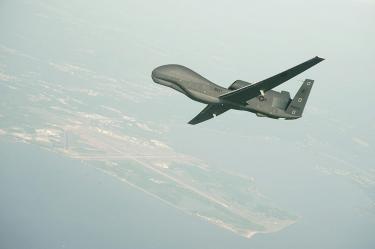The US will use its most advanced unmanned reconnaissance aircraft to monitor Chinese activity in waters surrounding the Diaoyutai Islands (釣魚台), the object of an acrimonious dispute between Beijing and Tokyo, Japanese media are reporting.
The decision was made during a meeting between Japanese Defense Minister Satoshi Morimoto and US Secretary of Defense Leon Panetta at the Pentagon on Sunday, NHK and the Yomiuri Shimbun said, adding that the drones would also conduct surveillance around Okinawa.
At least three unarmed Northrop Grumman RQ-4 Global Hawk drones have been deployed at Andersen Air Force Base on Guam since September 2010, bolstering the operational intelligence capabilities of US forces in the Asia-Pacific.
Operating at an altitude of about 18,000m, the RQ-4 provides near-real-time, long-range intelligence, surveillance and reconnaissance imagery by means of a high-resolution synthetic aperture radar. It played a role in damage assessment following the disaster at Japan’s Fukushima Dai-ichi nuclear power plant in March last year.
Amid rising tensions between Japan and China over the disputed islets, the Japan Maritime Self-Defense Force has mostly relied on P-3C “Orion” surveillance aircraft to monitor Chinese naval activity in the area.
Taiwan also claims sovereignty over the islands.
Tetsuo Kotani, a fellow at The Japan Institute of International Affairs in Tokyo, said the deployment sends an important message.
“One of the urgent issues for the US-Japan alliance is to enhance intelligence, surveillance and reconnaissance [ISR] cooperation,” he told the Taipei Times yesterday. “The Global Hawk can serve as a symbol of allied ISR cooperation.”
“This is an important step for the alliance and sends a strong message to Beijing thatWashington stands firmly with Tokyo,” he said.
Although the US does not officially take a position on the sovereignty dispute, some believe the Diaoyutais fall within the scope of Article 5 of the US-Japan Treaty of Mutual Co-operation and Security.
However, Kotani said Beijing should not misunderstand the real message.
“This is US reassurance to Japan. As long as Japan is reassured by the US, Japan does not have to take provocative actions vis-a-vis Beijing over the Senkakus,” he said. “No country wants to increase the tensions.”
The Diaoyutais are known as the Senkaku Islands in Japan.
During Sunday’s meeting, Panetta and Morimoto also agreed to explore eventual revisions of the Guidelines for Japan-US Defense Cooperation, which govern cooperation between the Japan Self-Defense Forces and the US military during crises.
Passed in 1978, the guidelines were substantially revised in 1997 in response to the North Korean nuclear program.
“We shared the view that it’s important to jointly study and discuss [security matters], taking into consideration changes in the security environment and what Japan-US cooperation should be,” Morimoto told a press conference.
According to the Yomiuri Shimbun, the review will focus on defense cooperation on the Nansei Islands in response to Chinese military expansion and increasing activity in waters surrounding Japan, as well as North Korea’s nuclear and missile development and post-disaster cooperation.
No specific procedures or timeline for the review were discussed.
* Notícia publicada al Taipei Times. Que la situació a les Senkaku / Diaoyutai és tensa, no és cap novetat. Ara bé, el possible destí d'aparells com el Global Hawk nord-americans és tot un missatge.

Cap comentari:
Publica un comentari a l'entrada